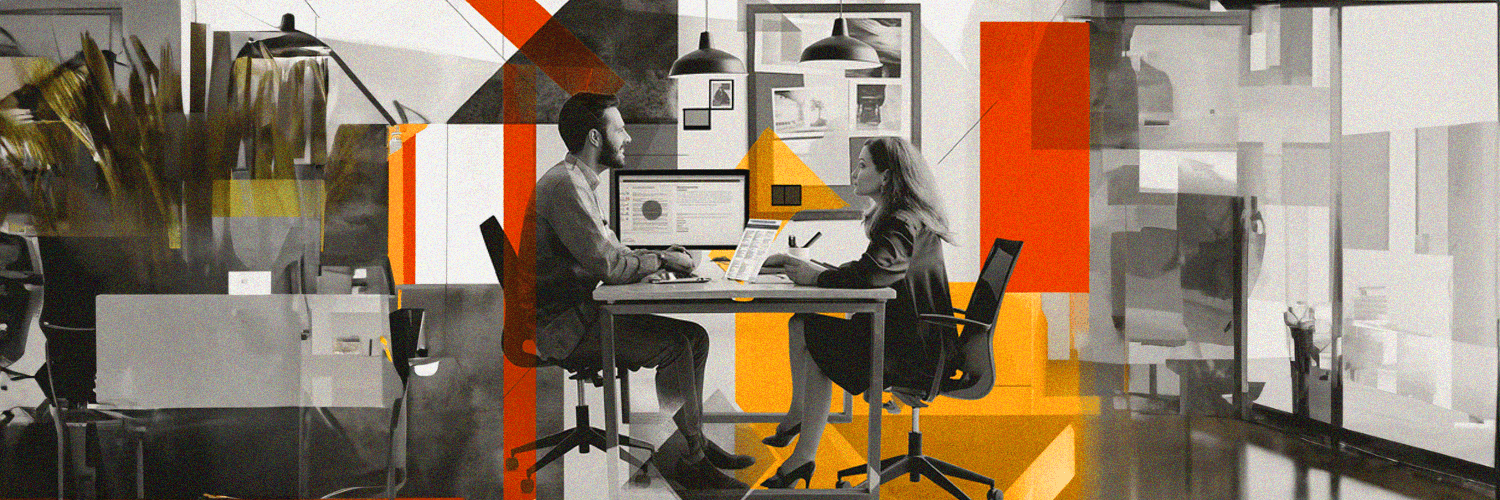The modern office is changing. As a result of the COVID-19 pandemic, offices worldwide have had to reinvent how they manage space and their employees within that space. Health and safety are significant factors to how companies manage their office space, in addition to a newfound appreciation for accommodating personal preferences in a work environment. As employees return to the office, they still desire the autonomy and flexibility that they discovered while working from home. Fortunately, facilities managers can offer this through hot-desking.
TL;DR:
- The modern office is changing due to the COVID-19 pandemic.
- Health and safety are significant factors in managing office space.
- Employees still desire autonomy and flexibility.
- Hot desking is an office organization system that allows employees to select any available desk.
- Hot desking is a simple solution to create the flexible work environment that employees crave.
- Desk spaces must be kept clean and free from personal belongings at all times.
- Hot desking is an ad-hoc office organization system and does not require any prior reservations.
- Hot desking eliminates organizational hierarchy, allows flexibility and promotes social interaction between employees, and is cost and space-efficient.
- With hot-desking, employees can choose where they sit on a given day, enabling collaboration and networking within the office.
- Hot desking provides employees with the same sense of flexibility and autonomy as working from home.
What is Hot Desking?
Hot desking, sometimes also called desk sharing, is an office organization system that allows employees to select any available desk when they come to work. This provides an alternative to working from the same assigned desk every day and instead will enable employees to find a workspace on a first-come, first-served basis. As 52% of workers in the US express a growing desire for flexibility in the workplace, setting up hot desks is a simple solution to create the flexible work environment that employees crave. In addition to that, it simplifies office management and improves space utilization by increasing the ratio of people to desks.

How Does Hot Desking Work?
The hot desking working principle is very simple. Employees are provided with a pool of desks and allowed to choose any workspace in the entire office - ideally, a different one every day. Depending on their preferences, some office workers may even change their workstation a few times per shift. Because of that, desk spaces must be kept clean and free from personal belongings at all times.
Hot desking is an ad-hoc office organization system and does not require any prior reservations. However, many hot desk offices have recently been adopting on-the-spot booking policies to maintain workplace safety and gain better visibility into space utilization.
Hot desking is commonly mistaken with desk hoteling, which, despite being based on a first-come, first-served basis, requires employees to reserve a space (for example, through a booking system) before they may use it. Therefore, the two terms should not be used interchangeably.
The Benefits of Hot Desking
Hot desking entails many wall-breaking ideas of the pioneers of the open office. It may not be everyone’s cup of tea, but its benefits are undeniable. By applying the same seating rules to everyone, hot desking eliminates organizational hierarchy, allows flexibility and promotes social interaction between employees. Above all, it is cost and space-efficient. Having multiple employees sharing one workstation helps company owners cut down costs on expensive office leases.
Here’s what you can achieve by implementing hot desking in your organization:
Improve Collaboration
As a facilities manager, a significant portion of your job is to cultivate a positive work environment where employees feel empowered to succeed. An essential aspect of an individual's success within a company is their ability to collaborate. After all, no task or project is completed entirely by one person but rather by a team of skilled professionals. Fortunately, hot desking is a great enabler of collaboration.
With hot-desking, employees can choose where they sit on a given day. This means that when they are working on a project with a team, they can sit in close proximity to their team members, ensuring that all aspects of the project are communicated and cohesive. Desk management software also enables employees to book conference rooms, ensuring that teams have the space they need to work as a group without interruption.
Furthermore, hot-desking cultivates networking within the office. In a traditional office with assigned seats, employees interact with the same colleagues every day. With hot-desking, employees can interact with individuals they may not have spoken to otherwise. This creates a greater sense of community within the company while offering networking opportunities.

Increase Flexibility and Autonomy
While working remotely over the past year, professionals have experienced a sense of flexibility and autonomy unheard of in the traditional office. Employees could work more flexible hours, take breaks as needed, and choose their work environment every day – whether that be at a desk or on the couch. As employees return to the office, they are hesitant to lose this flexibility. Fortunately, with hot-desking, they don't have to.
Hot desking enables employees the same sense of flexibility as to when they worked from home. Employees can book a desk according to their preference or activities on a given day. This allows employees to choose a workspace that they feel most productive and comfortable in, increasing employee satisfaction.
To take flexibility one step further, many organizations are implementing hybrid workweeks as well. The hybrid workweek allows employees to choose which days of the week they prefer to work remotely or in the office. This provides employees with a flexible schedule that caters to their desire for autonomy. An individual can choose to come into the office on days when meetings are scheduled and work at home when working on a project that involves a high level of focus.
Manage Office Capacity
While businesses are beginning to recover from the effects of the pandemic, we are living in a new normal. Now more than ever, safety is a priority in the office. While employees are returning to the office, they have new safety and social distancing expectations, and there are new protocols to follow. For employees to perform the work expected of them, they must feel safe within the office to do so.
With hot-desking, managing social distancing and office capacity is a breeze. Using desk booking software, management can track how many desks are occupied at a given time, making it simple to record and track capacity. Additionally, facilities managers will have the ability to block off specific desks or areas from employees, ensuring that all individuals in the office keep a safe distance from one another. Individuals who are more hesitant to return to the office have the option to choose a private desk secluded from others. In contrast, those comfortable in a group setting can choose to work in a communal area. Whatever workspace makes employees most comfortable, hot desking can accommodate.

Promote Productivity
There is no question that individuals perform better and are more productive when in an environment of their preference. For some, they are more productive when in a quiet area that cultivates focus and serenity. For others, collaboration and social buzz incite productivity. With hot-desking, employees book a desk in an environment that nurtures their personalized sense of productivity.
Many studies have shown that employees have been more productive while working from home because they are in control of their environment. However, if your employees decide to return to the office, this sense of control is not lost. Hot desking enables this same boosted level of productivity by allowing employees to work where they feel most productive. This, in turn, increases employee performance, which is a win-win for both the company and its workforce.

Reduce Office Space Expenses
Office spaces are expensive to manage and require frequent maintenance. Many companies have significantly invested in their offices over the past year while employees worked remotely, so they are eager to get their workforce back into the office. Even so, as remote work becomes more popular, there is no longer as pressing of a need for office space as before. As a result, hot desking is a great way to cut costs on the workspace, minimizing the need for as much space.
In allowing employees to work where they want, you reduce the amount of office space that your company needs. Some employees may choose to continue working remotely, but those eager to return to the office can benefit from hot desking. As desks can be shared between employees' revolving schedules, fewer desks are required. This means that while employees can work where they are most comfortable, your organization saves considerably on unnecessary office costs.
Hot desking is a new concept to many companies, but it is the future of the modern workplace. Enabling employees to choose their own workspace cultivates a sense of productivity and flexibility while cutting office management costs and complying with safety protocols. With hot-desking in your toolbox, managing the office is easier than ever, and you will see the benefits with your very own eyes.
Create a More Inclusive and Equal Workplace Culture
Through hot desking, companies foster an environment where every employee, regardless of position or role, has equal access to workspace resources and opportunities. This system is crucial in forming an inclusive culture wherein everyone's input matters.
- It encourages collaboration & interaction: With no fixed seats, employees tend to interact with different colleagues each day which breaks down silos and promotes cross-team collaboration.
- It promotes transparency & openness: As there are no physical barriers like partitions separating senior management from other employees, hot desking supports open communication and ad-hoc discussions.
- It establishes equality: Everyone has the same access to space; therefore, it reduces perceived hierarchal gaps among staff members.
The Long-lasting Impact of Hot Desking on Businesses
Hot desking, the practice where employees do not have assigned cubicles or desks but instead use any available workstation, can create an enormous impact on businesses; it reshapes both corporate culture and resource utilization. This non-traditional office layout style encourages team collaboration and knowledge sharing, breaking down siloed departments while promoting cost-efficiency through optimized space utilization.
Potential Challenges and How to Overcome Them Effectively
While exploring the advantages of hot desking, it's essential to recognize potential challenges associated with its implementation.
- Dissatisfaction over lack of personal space: Employees may feel attached to their designated workspace. To combat such resistance, emphasize the benefits, such as opportunities for networking and collaboration.
- Lack of privacy: Frequent location changes could compromise privacy. Adapting quiet zones equipped with soundproof booths can help overcome this issue effectively.
- Health concerns: Shared workspaces can raise hygiene issues. Regular cleaning schedules and sanitary measures in shared spaces are critical to maintaining a safe workplace.
By strategically addressing these conflicting elements, you can promptly soothe possible roadblocks, ensuring the successful adoption of hot-desk practices in your organization.
Measuring The Success Of Hot Desking Through Data Analytics
How can you gauge the success of the hot desking model? The answer lies in diligent data analysis.
- Space utilization metrics: By constantly monitoring workstation usage, your organization can fine-tune seating arrangements for optimal use.
- Employee productivity: Compare productivity levels before and after implementing hot-desking. Note changes in project completion rates or idea generation.
- Employee feedback: Regular surveys help collect subjective experiences. Satisfaction levels provide insight into how comfortable employees feel with this new setup.
In conjunction with well-thought-out implementation strategies, transparent measurement criteria fortify the chances of reaping long-lasting benefits from hot-desking policies.
How to Implement a Hot Desking System?
Whether hot desking is your only seating policy, or just a part of a larger system, it shouldn’t be done manually. The first step to a successful hot desk policy is an efficient desk booking solution, which provides visibility to employees while keeping HR and Facilities Management departments in control.
If you want to make hot desking work, here are the key aspects you look for in a desk booking system:
- Real-time availability, because hot desking is all about spontaneous decisions. The office workers should have a clear overview of the available desks and be able to reserve the one they want with a few clicks.
- Mobile-friendliness, because it is important to make desk reservation accessible to everyone, at any time. Keeping the central booking engine in their pockets, employees can change hot desks whenever needed.
- Space usage tracking - to spot trends in workspace utilization and setting up a constructive cleaning strategy, for all that extra wiping and dusting not done by employees.
- Interactive office map and business rules - to provide employees with information about each desk, organize a safe activity-based working, and restrict the desks that are off-limits.
One of the solutions taking all of the above into account is our desk booking software, part of YAROOMS Workplace Experience Platform. We created it to be agile, so it can support different seating arrangements or even be adapted to non-corporate settings, such as parking lots or events.
Is Hot Desking the Right Fit for Your Organization?
It's vital to understand that every business model is unique and has specific needs aligned with its strategic goals. Therefore, thorough evaluation of hot desking policy is essential.
Firstly, dissecting organizational structure is an excellent place to start. Does your company lean towards a more collaborative work style where employees often ideate and execute in groups? If yes, hot desking could seamlessly enhance this teamwork ethic. It allows workers from different departments or teams to interact easily, leading to improved cross-functional collaborations and innovative ideas.
Secondly, take some time to examine your current office space utilization rates. Are there times during the day when many desks are unoccupied? Analyzing actual workspace usage can provide invaluable insight into your spatial needs and help identify any potential efficiencies you might garner through implementing a hot desking strategy.
Thirdly, consider the nature of work carried out by most staff members. If they frequently attend outside meetings or work remotely part of the week, then investing in dedicated desk spaces can be financially draining when those desks sit idle half of the time.
Through assessing these elements mindfully - teamwork necessities, spatial usage rates, and remote working preferences, you'd gain insight into whether transforming your office layout would bring any benefits of hot desking into play.
It's essential also to use key performance metrics in evaluating if introducing 'hot desks' might increase overall productivity levels or instigate cost-saving potentials. With data analytics progressively becoming a crucial decision-making tool for businesses worldwide – using metrics such as employee feedback scores before and after the implementation of the hot desking method could prove decisive in measuring its success within your organization's environment.
Looking beyond the monetary advantages of hot desking, like reduction in real estate costs, does blending hierarchies align with your culture growth plan? Would creating a space that encourages employees to interact more freely with other departments influence the creation of your aspired inclusive workplace environment? Reflecting on these considerations can help tailor a decision suitable for your unique company ethos.
Tread carefully, plan wisely, and remember – change, though often beneficial, must align perfectly with the organization's ethos for maximum benefit.

Hot Desking FAQ
How Much Does Hot Desking Cost?
The biggest investment you will make when implementing hot desking is a desk booking solution. Because of that, it is important to select a reliable vendor that can offer all the features you need with a transparent price tag. In very rare cases, companies may also need to allocate some budget for a minimal office redesign. In the long term, you can expect a large pay-off, as hot desking can reduce the office maintenance costs by as much as 30%.
How to Choose the Right Hot Desk Booking System?
An agile desk booking system is an essential asset if you want to implement hot desking successfully. To get the most out of it, look for:
- Real-time availability
- Mobile-friendliness
- Space utilization tracking
- Interactive office map
- Advanced space search functionality
- Support for different business rules
- Check-in functionality
These features will help your employees to quickly locate available spaces while eliminating conflicts over popular seats and reducing the number of unproductive no-shows.
What Are the Best Reasons for an Office to Adopt Hot Desking?
The best reasons for an office to adopt hot desking include increased collaboration, flexibility, and cost savings on office space. It can also encourage a more mobile and dynamic workforce, and allow for better use of office resources.
Is Hot Desking Effective?
The effectiveness of hot desking depends on various factors such as the nature of the work, the culture of the organization, and the preferences of the employees. Some studies have shown that it can lead to increased collaboration and productivity, while others have shown a potential decrease in productivity due to the lack of personalization and stability. Ultimately, it is up to each organization to evaluate whether hot desking is the right fit for their needs.
How to Introduce Hot Desking?
Roll-out hot desking in your organization by following these simple steps:
- Define a clear hot desking policy, procedures, and establish the roll-out timeline.
- Communicate your plans to your workforce and ask for feedback.
- Adjust your initial plan depending on employee feedback.
- Start the hot desking trial period.
- Gather feedback along the way.
- Improve your hot desking processes.
- If the trial period is a success, dive right in.









